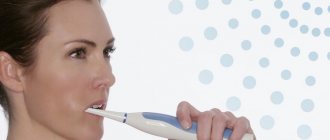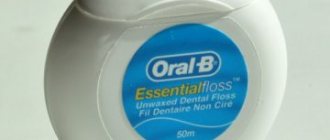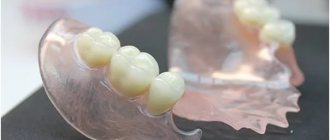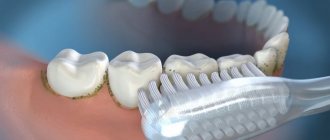When should you use mouthwash?
With halitosis. If bad breath occurs frequently, a mouthwash will help remove it. It reduces the number of bacteria, slows down their reproduction, and cleans even those areas that cannot be reached with a toothbrush (subgingival, interdental areas, surface of the tongue, gums, cheeks). When rinsing, residues and food particles are washed away, which can cause an unpleasant odor.
If caries appears frequently. It is formed when plaque accumulates on the enamel, when the acidity in the mouth becomes too high (including due to the active growth of bacteria). Antibacterial solutions help reduce acidity, and additional cleansing reduces plaque formation. The mouthwash may contain fluorides or other mineral components that strengthen the enamel, restore its structure, and protect against caries.
With the rapid appearance of tartar. It is formed when soft plaque hardens. It can only be removed with professional cleaning. To prevent tartar from appearing again, effective hygiene is important. Using rinses, you can slow down the formation of deposits: they wash the enamel surface, remove food particles, slow down the growth of bacteria, and help keep teeth clean throughout the day.
If the enamel is highly sensitive. In this case, you need to use solutions with a mineralizing effect. They must contain fluorides. When rinsed, they penetrate the enamel structure, restore it, strengthen it and reduce sensitivity. It’s good if the solution is also antibacterial: it will help reduce acidity in the mouth, eliminating pain.
For bleeding or inflammation of the gums. The use of solutions with anti-inflammatory and antibacterial effects is part of the prevention and treatment of gum disease. They help relieve inflammation, accelerate the healing of the mucous membrane, and slow down the formation of tartar under the gingival margin.
We need hygiene, hygiene is important to us
Let's now talk about how a patient can take care of himself and his teeth at home
How to carry out proper dental hygiene at home.
Let's start with the fact that no one has canceled mechanical teeth cleaning with a toothbrush. The toothbrush must be selected according to the condition of the oral cavity, based on the current conditions in the oral cavity. After all, it happens that a patient is prescribed, due to a number of factors, a soft brush, a medium-hard brush, or a hard one. It's not just how it's done.
In a good way, the selection of household hygiene products in the dental line should be done by a hygienist, at a minimum. But here, it turns out, everyone prescribes their own brush and toothpaste and uses whatever they want.
So, the personal hygiene item that Vasily should have is a toothbrush - this is the first
. And, by the way, the toothbrush also needs its own hygiene. But few people remember this.
Selection of oral hygiene products in the form of toothpastes and powders
now more than diverse. But it is impossible to recommend anything effective for patients; this is a known fact. Moreover, in the household line of toothpastes, their composition is approximately the same, and the use of medicinal toothpastes as a means of treatment is best discussed with the dentist at a clinic appointment.
Second
— Vasily’s mandatory use of floss. Floss is a dental floss that can be used to clean areas where brushing is not possible. Also, be sure to use floss after meals - this is very good.
How to improve gum microcirculation
In addition to threads, there are devices such as irrigators.
There are a large variety of them, ranging from portable ones to stationary irrigators that need to be installed at home.
This is a separate topic, and I think it’s a very good tool in a comprehensive approach to hygiene.
The irrigator helps clean out food debris (and not only food debris), helps clean the oral cavity and also massages the gums. Under the influence of an irritating massage, when streams of water hit the gums, the bed of blood vessels expands. Due to this, blood flow to this particular place increases, that is, through this massage we improve trophism - that is, nutrition, blood circulation. The greater the blood circulation, the more nutrients and microelements there are in the tooth tissue, because they are also nourished.
As a matter of fact, if you take Vasily through all the above mentioned on oral hygiene as a whole, then it will be simply great to be healthy. Your teeth will be perfect!
But remember that professional teeth cleaning has never been canceled.
What types of mouth rinses can there be?
For self-hygiene, solutions with antibacterial, antiseptic, mineralizing, anti-inflammatory, and antifungal effects can be used. It is better to use a rinse selected by your dentist or hygienist, taking into account the condition of your teeth and gums.
Mineralizing. The basis of the solution is sodium fluoride or olafur. This is a mineral component that can penetrate the enamel structure and strengthen it. After rinsing, a protective film is formed on the surface of the teeth. It lasts for several hours, “saturating” the enamel with minerals. The use of such rinses reduces the risk of caries and reduces the sensitivity of enamel.
Antiseptic. The main component may be chlorhexidine, triclosan, or benzydamine in low concentrations. The solution destroys bacteria, protects against gum disease, slows down the formation of tartar, and improves the condition of gingivitis and some other diseases. After tooth extraction, rinsing with antiseptic solutions may be prescribed to reduce the risk of inflammation or dry socket formation. Rinse aids with an antiseptic effect are used as prescribed by the attending physician. They are usually used as part of complex therapy in the treatment of periodontitis, gingivitis and other inflammatory diseases. You cannot use them for too long: this is dangerous due to dysbacteriosis of the oral cavity, dry mucous membranes, and the appearance of halitosis.
Health-improving. They are made from extracts or decoctions of herbs, using essential oils. The effect is mild, supportive or preventive (not pronounced enough if treatment of existing diseases is needed). Such rinses can contain extracts of chamomile, myrrh, sage, eucalyptus, sea buckthorn, hawthorn, essential oil of geranium and other plants. Their effect is anti-inflammatory, restorative, restoring local immunity. Such products are used as a means of daily hygiene. Even with long-term use they do not cause side effects.
Alcohol based. They are classified as antiseptic, used as prescribed by a doctor, the ethanol content can be up to 27%. Effective for halitosis and inflammatory diseases of the oral cavity. They cannot be used by minors, people for whom alcohol is contraindicated, or drivers (after rinsing, the breath may contain alcohol vapor, and this is recorded during testing with a breathalyzer).
Some rinses are used as prescribed by a doctor for specific diseases or conditions. They may include:
- diphenhydramine - for a local allergic reaction;
- xylocaine or lidocaine - anesthetic effect (temporarily removes sensitivity);
- nystatin, betamethasone, stomatidine - for aphthous stomatitis and other acute inflammations;
- benzydamine is a pain reliever.
How does professional cleaning happen in the doctor's chair?
Hygienists have several professional teeth cleaning tools at their disposal. One of these tools using Air Flow
. This is a device that promotes hygiene with the help of a fine sand-like abrasive placed in this device, that is, it cleans the teeth and the surface of the teeth from soft and hard stone. I do my own oral hygiene this way - I like it. Air Flow is more gentle and gentle. And if you work with four hands with an assistant, it is very convenient for the patient.
But ideally, to ensure proper dental hygiene, you need to use the entire range of tools that exist.
In addition to Air Flow, there is also ultrasound - an ultrasonic scaler.
This is an attachment that is installed on the scaler itself.
Ultrasonic movements help remove hard plaque.
How to remove tartar in hard-to-reach places
In addition to ultrasound, there is mechanical cleaning using a Gracie curette
. This is a special instrument designed to do mechanical cleaning and hygiene began with these curettes.
Curettes are a handle with a working part on each side. The working part is a sharp edge. The angles of inclination on one side of the curette and on the other are different. The curette is convenient to work on both the upper and lower jaws. That is, it is convenient to get to - easy access.
An American housewife invented curettes.
Part of the plaque is removed mechanically and then polished using a soft brush and paste. Great practical feminine approach, isn't it? PS
Visiting the dentist twice a year was invented back in the Soviet Union under Soviet healthcare, and it was actually considered one of the best, by the way.
Recommendations for maintaining oral and dental health in old age
In order to preserve your teeth and prevent, as far as possible, oral diseases, it is important to take care of your oral and dental health.
Oral hygiene – brushing teeth and using devices to clean the space between teeth is important even in old age. It is necessary to brush your teeth twice a day with a soft toothbrush and toothpaste containing fluoride. If you have limited mobility, you can use an electric toothbrush.
Caring for Dentures – Bacteria are found on dentures just like they are on teeth. Dentures should be cleaned every day and removed from the mouth at night. To keep dentures clean, you need to clean them with a special brush. If your denture is not in your mouth, soak it in a denture disinfectant solution.
Quitting Smoking – In addition to causing other types of health damage, smoking can make gum problems worse. It has a negative impact on recovery after dental procedures and on the placement of implants. In addition, smoking increases the risk of oral cancer.
Alcohol use – In addition to causing other types of health harm, drinking alcohol increases the risk of oral cancer.
Healthy diet – a diet rich in fresh vegetables and fruits is a protective factor against oral cancer.
Monitoring and Prevention – If you experience a sore in your mouth that does not go away within two weeks, have it checked by your dentist. Oral cancer does not cause pain in the early stages, so it is important to have routine checkups with your dentist even if there are no changes in your mouth.
Treating Dry Mouth – In some cases where dry mouth is caused by medication, your doctor may be able to prescribe an alternative medication to resolve the problem. To reduce dry mouth, it is recommended to drink plenty throughout the day. You can use chewing gum or sugar-free candy, or, in certain cases, even saliva substitutes.
Prevention and treatment of fungal diseases - daily measures to maintain oral hygiene and dentures are very helpful in preventing fungal diseases. If you have a fungal infection in your mouth, you should check with your dentist. Treatment for fungal infection can be local or systemic.
Periodic dental checkups – It is recommended to have routine checkups at least once a year with your dentist. It is important to inform your dentist of any changes in your health, including changes in medications, as these changes can have a decisive impact on your dental treatment.
Putting drops in the ears
- clean the external auditory canal with a sterile cotton swab (if there is suppuration)
- warm the drops to body temperature, for which the bottle is placed in water at a temperature of 37.2-37.3 C
- place the child on the healthy side;
- to straighten the external auditory canal in a young child, the earlobe is pulled slightly downwards with the left hand, and in older children the auricle is pulled upward and backward;
- holding the pipette in a vertical position in the right hand, 5-6 drops of the medicinal solution are injected into the ear;
- after administering the drops, press the tragus several times so that the drops enter the middle ear; — place a cotton swab in the ear for 15-20 minutes;
- after administering the drops, the child must be kept in a lying position on his healthy side or back with the sore ear turned upward for 15-20 minutes;
- If drops are prescribed in both ears, it is not recommended to carry out this manipulation simultaneously.











